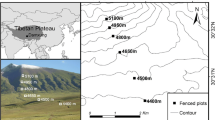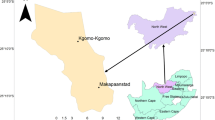Abstract
Saccharum spontaneum L. is a perennial tall grass and invades naturally abandoned and pastoral lands in many tropical countries. Although it is a potentially multiple-use and multifunctional species, it remains neglected and underutilized. It is commonly known as ‘Wild cane’ in English and ‘Kans’ in Hindi. In recent years, S. spontaneum has attracted serious attention for its potential in ecological restoration. The present paper deals with geographic distribution, ecology, morphological description, multiple uses, restoration potential, and propagation of this species. We also report the suitability of S. spontaneum for the restoration and stabilization of bare fly ash (FA) dumps. In this context, the highest importance value index, visual observations and practitioner insights reveal that S. spontaneum has great ability to grow on bare FA dumps and can be used as an ecological tool in restoration of vast tracts of fly ash dumps across the world. Besides grass vegetation study, we also report the change in physicochemical properties of abandoned site and compared with naturally colonized site with S. spontaneum of FA dumps to assess its ecological suitability for restoration of bare FA dump. Overall, the field results showed that S. spontaneum is a promising and potential tall grass for the restoration of FA dumps.

Similar content being viewed by others
References
Amritphale D, Mall L (1978) Allelopathic influence of Saccharum spontaneum L. on the growth of three varieties of wheat. Sci Cult 44:28–30
Anonymous (1972) The Wealth of India. Raw materials. CSIR Publications & Information Directorate. Vol. IX, New Delhi, India
Artschwager E (1942) A comparative analysis of the vegetative characteristics of some variants of Saccharum spontaneum, USDA technical bulletin 811. USDA, USA
Babu AG, Reddy MS (2011) Dual inoculation of arbuscular mycorrhizal and phosphate solubilizing fungi contributes in sustainable maintenance of plant health in fly ash ponds. Water Air Soil Pollut 219:3–10
Balyan RS, Yadav A, Malik RK, Pahwa SK, Panwar RS (1997) Management of perennial weeds. Bulletin, Department of Agronomy. CCS Haryana Agricultural University, Hisar
Bhandari MM (1990) Flora of the Indian desert. Pbl. MPS Repros, Jodhpur, pp 390–391
Bhatt V (1990) Biocoenological succession in reclaimed rock phosphate mine of Doon Valley. Ph.D. thesis, H.N. Bahuguna Garhwal University, Srinagar, UK
Blight G.E (1987) Lowering the groundwater table by deep rooted vegetation. The geotechnical effects of watertable recovery. Proceedings of the ninth european conference. Soil Mechanics and Foundation Engineering, Dublin, pp 285–288
Bor NL (1960) Grass. Burma, Ceylon, India and Pakistan i–xviii, 1–767. Pergamon Press, Oxford
Chandel AK, Singh OV, Rao VL, Chandrasekhar G, Narasu ML (2011) Bioconversion of novel substrate Saccharum spontaneum, a weedy material, into ethanol by Pichiastipitis NCIM3498. Bioresour Technol 102:1709–1714
Chaulya SK, Singh RS, Chakraborty MK, Dhar BB (1999) Numerical modelling of biostabilisation for a coal mine overburden dump slope. Ecol Model 114:275–286
Chaulya SK, Singh RS, Chakraborty MK, Srivastava BK (2000) Quantification of stability improvement of a dump through biological reclamation. Geotech Geol Eng 18:193–207
Cook CDK (1996) Aquatic and wetland plants of India. Oxford University Press, Oxford
Cootam G, Curtis JT (1956) The use of distance measures in phytosociology sampling. Ecology 37:451–460
Curtis JT, McIntosh RP (1950) The interrelations of certain analytic and synthetic phytosociological characters. Ecology 31(3):434–455
Dangol DR (2005) Species composition, distribution, life forms and folk nomenclature of forest and common land plants of western Chitwan. Nepal J Inst Agric Animal Sci 26:93–105
Das M, Dey S, Mukherjee A (2013) Floral succession in the open cast mining sites of Ramnagore Colliery, Burdwan District, West Bengal. Indian J Sci Res 4:125–130
Datta S, Banerjee A (1973) Weight and number of weed seeds. Proceedings of the 4th Asian-Pacific weed science society conference. Asian Pacific Weed Science Society 1:87–91
Doren RE, Richards JH, Volin JC (2009) A conceptual ecological model to facilitate understanding the role of invasive species in large-scale ecosystem restoration. Ecol Ind 9:150–160
Dowarah J, Deka Boruah HP, Gogoi J, Pathak N, Saikia N, Handique AK (2009) Eco-restoration of a high-sulphur coal mine over burden dumping site in northeast India: a case study. J Earth Syst Sci 118:597–608
Duthie JF (1960) Flora of upper Gangatic plain and of the adjacent Shiwalic and Sub-Himalayan Tract, vol 2. Rep. Edi. Botanical Survey of India, Calcutta
Graham DB, Josef NSK, Kristin S (2014) The reproductive biology of Saccharum spontaneum L.: implications for management of this invasive weed in Panama. NeoBiota 20:61–79
Holm L, Doll J, Holm E, Pancho J, Herberger J (1997) World weeds. Natural Histories and Distribution Wiley, New York
Hussain A (1995) Fill compaction-erosion study in reclaimed areas. Indian Mining Eng J 34(6):19–21
Kaith BS, Jindal R, Maiti M (2009) Induction of chemical and moisture resistance in Saccharam spontaneum L. fiber through graft copolymerization with methyl methacrylate and study of morphological changes. J Appl Polym Sci 113:1781–1791
Kaith BS, Jindal R, Jana AK, Maiti M (2010) Development of corn starch based green composites reinforced with Saccharum spontaneum L. fiber and graft copolymers—Evaluation of thermal, physicochemical and mechanical properties. Bioresour Technol 101:6843–6851
Komarov VL, Rozhevits RY, Shishkin BK (1963) Flora of the USSR. The Botanical Institute of the Academy of Sciences of the USSR, Leningrad, USSR
Koranda M, Schnecker J, Kaiser C, Fuchslueger L et al (2011) Micro-bial processes and community composition in the rhizosphere of Euro-pean beech: the influence of plant C exudates. Soil Biol Biochem 43:551–558
Kullu B, Behera N (2011) Vegetational succession on different age series sponge iron solid waste dumps with respect to top soil application. Res J Environ Earth Sci 3:38–45
Kumar CAS, Varadharajan R, Muthumani P, Meera R, Devi P, Kameswari B (2010) Psychopharmacological studies on the stem of Saccharum spontaneum. Int J PharmTech Res 2(1):319–321
Kumari A, Pandey VC, Rai UN (2013) Feasibility of fern Thelypteris dentata for revegetation of coal fly ash landfills. J Geochem Explor 128:147–152
Maiti SK, Jaiswal S (2008) Bioaccumulation and translocation of metals in the natural vegetation growing on fly ash lagoons: a field study from Santaldih thermal power plant, West Bengal, India. Environ Monit Assess 136:355–370
Maiti SK, Nandhini S (2006) Bioavailability of metals in fly ash and their bioaccumulation in naturally occurring vegetation: a pilot scale study. Environ Monit Assess 116:263–273
Mishra BK, Verma VK (1992) Flora of Allahabad district Utter Pradesh, India. Bishen Singh Mahendra Pal Singh, Dehradoon
Olsen SR, Cole CV, Watanable FS, Dean LA (1954) Estimation of available phosphorus in soils by extraction with sodium bicarbonate. USDA Circular No. 939. U.S. Government Printing Office, Washington, DC
Pancho J (1964) Seed sizes and production capacities in common weed species of the rice fields of the Philippines. Philipp J Weed Sci 12:75–98
Pancho J, Obien S (1983) Manual of Weeds of Tobacco Farms in the Philippines. Quezon City, Philippines: New Mercury Printing Press. Panje R, 1970. The evolution of a weed. PANS 16:590–595
Pandey VC (2012a) Invasive species based efficient green technology for phytoremediation of fly ash deposits. J Geochem Explor 123:13–18
Pandey VC (2012b) Phytoremediation of heavy metals from fly ash pond by Azolla caroliniana. Ecotoxicol Environ Saf 82:8–12
Pandey VC (2013) Suitability of Ricinus communis L. cultivation for phytoremediation of fly ash disposal sites. Ecol Eng 57:336–341
Pandey VC, Kumar A (2013) Leucaena leucocephala: an underutilized plant for pulp and paper production. Genet Resour Crop Evol 60:1165–1171
Pandey VC, Singh N (2010) Impact of fly ash incorporation in soil systems. Agric Ecosyst Environ 136:16–27
Pandey VC, Singh K (2011) Is Vigna radiata suitable for the revegetation of fly ash basins? Ecol Eng 37:2105–2106
Pandey VC, Singh B (2012) Rehabilitation of coal fly ash basins: current need to use ecological engineering. Ecol Eng 49:190–192
Pandey VC, Singh N (2014) Fast green capping on coal fly ash basins through ecological engineering. Ecol Eng 73:671–675
Pandey VC, Abhilash PC, Singh N (2009) The Indian perspective of utilizing fly ash in phytoremediation, phytomanagement and biomass production. J Environ Manage 90:2943–2958
Pandey VC, Singh JS, Singh RP, Singh N, Yunus M (2011) Arsenic hazards in coal fly ash and its fate in Indian scenario. Resour Conser Recycl 55:819–835
Pandey VC, Singh K, Singh RP, Singh B (2012) Naturally growing Saccharum munja on the fly ash lagoons: a potential ecological engineer for the revegetation and stabilization. Ecol Eng 40:95–99
Pandey VC, Prakash P, Bajpai O, Kumar A, Singh N (2014a) Phytodiversity on fly ash deposits: evaluation of naturally colonized species for sustainable phytorestoration. Environ Sci Pollut Res. doi:10.1007/s11356-014-3517-0
Pandey VC, Singh N, Singh RP, Singh DP (2014b) Rhizoremediation potential of spontaneously grown Typha latifolia on fly ash basins: study from the field. Ecol Eng 71:722–727
Panje R (1970) The evolution of a weed. PANS 16:590–595
Park A, Friesen P, Aracelly A, Serrud S (2010) Comparative water fluxes through leaf litter of tropical plantation trees and the invasive grass Saccharum spontaneum in the Republic of Panama. J Hydrol 383:167–178
Ram LC, Jha SK, Tripathi RC, Masto RE, Selvi VA (2008) Remediation of fly ash landfills through plantation. Remediation 18:71–90
Ram LC, Masto RE (2014) Fly ash for soil amelioration: a review on the influence of ash blending with inorganic and organic amendments. Earth Sci Rev 128:52–74
Ribeiro J, Silva TF, Mendonça Filho JG, Flores D (2014) Fly ash from coal combustion-an environmental source of organic compounds. Appl Geochem 44:103–110
Ruiz-Sinoga JD, Pariente S, Diaz AR, Martinez Murillo JF (2012) Variability of relationships between soil organic carbon and some soil properties in Mediterranean rangelands under different climatic conditions (South of Spain). Catena 94:17–25
Sastri CST, Kavathekar KY (1990) Plants for reclamation of wastelands. Pbl. CSIR, New Delhi, pp 360–362
Scordia D, Cosentino SL, Jeffries TW (2010) Second generation bioethanol production from Saccharum spontaneum L. ssp. aegyptiacum (Willd.) Hack. Bioresour Technol 101:5358–5365
Sharma S, Tiagi B (1979) Flora of North East Rajasthan. Kalyani Publishers, New Delhi
Singh L, Soni P (2010) Binding capacity and root penetration of seven species selected for revegetation of uranium tailings at Jaduguda in Jharkhand, India. Curr Sci 99:507–513
Singh JS, Pandey VC, Singh DP (2011) Efficient soil microorganisms: a new dimension for sustainable agriculture and environmental development. Agric Ecosyst Environ 140:339–353
Singh K, Pandey VC, Singh B, Singh RR (2012) Ecological restoration of degraded sodic lands through afforestation and cropping. Ecol Eng 43:70–80
Singh K, Pandey VC, Singh RP (2013) Cynodon dactylon: an efficient perennial grass to revegetate sodic lands. Ecol Eng 54:32–38
Thakur C (1984) Weed science. Metropolitan Book Co. (P) Ltd., New Delhi
Tormo J, Bochet E, García-Fayos P (2007) Roadfill revegetation in Semiarid Mediterranean Environments. Part II: topsoiling, species selection, and Hydroseeding. Restor Ecol 15:97–100
Uphof J (1968) Dictionary of economic plants. Cramer, New York
Verma SK, Singh K, Gupta AK, Pandey VC, Trivedi P, Verma RK, Patra DD (2014) Aromatic grasses for phytomanagement of coal fly ash hazards. Ecol Eng 73:425–428
Walkley A, Black IA (1934) An examination of the Degtjareff method for determining organic carbon in soils: effect of variations in digestion conditions and of inorganic soil constituents. Soil Sci 63:251–263
Wapakala W (1966) A note on the persistence of mulch grasses. Kenya Coffee 31:111–112
Acknowledgments
Financial support given to first author as Young Scientist by Science and Engineering Research Board, Department of Science & Technology, Govt. of India (No. SR/FTP/ES-96/2012) is gratefully acknowledged. Author is also thankful to Dr. C.S. Nautiyal, Director, CSIR-National Botanical Research Institute, Lucknow for his kind support.
Author information
Authors and Affiliations
Corresponding author
Rights and permissions
About this article
Cite this article
Pandey, V.C., Bajpai, O., Pandey, D.N. et al. Saccharum spontaneum: an underutilized tall grass for revegetation and restoration programs. Genet Resour Crop Evol 62, 443–450 (2015). https://doi.org/10.1007/s10722-014-0208-0
Received:
Accepted:
Published:
Issue Date:
DOI: https://doi.org/10.1007/s10722-014-0208-0




